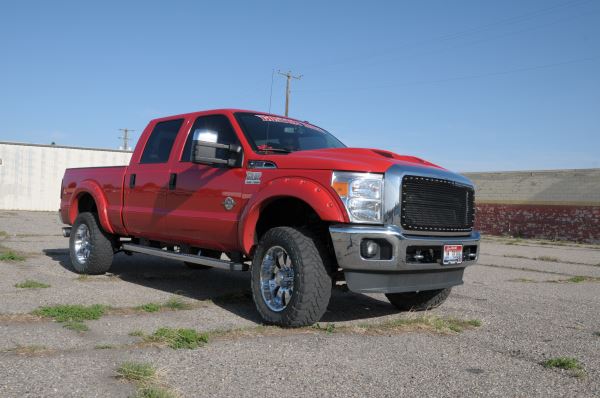 I still remember the first time I took a ride in a first-generation Dodge pickup with a Cummins power plant. The power was impressive compared to its opponents, but the ride was bone rattling. The suspension in those old trucks was compared to that of a buckboard on a wagon. In the past few issues we have worked from the ground up on a diesel-powered pickup including such topics as wheels, tires, brakes and axles. This particular column will focus on the suspension setups found on most modern diesel powered pickups on the front and rear axles.
I still remember the first time I took a ride in a first-generation Dodge pickup with a Cummins power plant. The power was impressive compared to its opponents, but the ride was bone rattling. The suspension in those old trucks was compared to that of a buckboard on a wagon. In the past few issues we have worked from the ground up on a diesel-powered pickup including such topics as wheels, tires, brakes and axles. This particular column will focus on the suspension setups found on most modern diesel powered pickups on the front and rear axles.
.JPG_600.jpg) Front Suspension
Front Suspension
Let’s begin by reviewing the different types of suspension setups found on the front axles of diesel-powered pickups throughout the years. We will first discuss the front axle of the diesel pickup trucks from oldest to newest. The Dodge pickup trucks were first outfitted with the Cummins engine starting in production year 1989. The Chevy heavy-duty pickup trucks were equipped with a 6.2L diesel engine in 1982 and the Fords received the 6.9L diesel in the same year as well. All of these trucks noticed weight increases over the front axle due to the diesel engine architecture opposed to the factory-equipped gasoline engines. The suspension of choice on the four-wheel drive Dodge, Ford and Chevy pickups in the three-quarter-ton and one-ton class was leaf springs and shock absorbers. The suspension of choice for the two-wheel drive diesel pickup trucks for all three major brands was coil-over spring suspension.
.JPG_600.jpg) Leaf Springs
Leaf Springs
All pickup trucks built in the last 60 years that were four-wheel drives have used leaf spring suspension. Since the first three-quarter-ton Dodge pickup was built in 1923 by the Dodge brothers, they have used leaf springs for part of their suspension. It is tried and true to say the very least. Leaf springs get their name from their long, leaf-type straps of spring steel usually found in a pack of one or more straps stacked on top of each other. The longest leaf or main strap usually has eyelets on each end, which hook to the shackles and brackets anchored to the frame. The heavier the weight above the leaf spring pack, the larger the pack was both in length and thickness. The leaf spring pack on the 1989-1993 Dodge Cummins powered trucks were a very thick pack and usually had six springs with the longest on top and the shortest on the bottom. The Chevy four-wheel drive diesel trucks had a very similar spring pack arrangement. The leaf springs used in this setup were constant thickness leaf springs. This means they were the same thickness from one end to the other. The Ford diesel equipped pickups in the 80s and 90s had a leaf pack of only two to four leafs. This particular type of spring pack was referred to as tapered leaf springs with the thick part of the leaf in the middle and the thin part at the end. It usually resulted in the use of less leaf springs in the pack and a smoother ride.
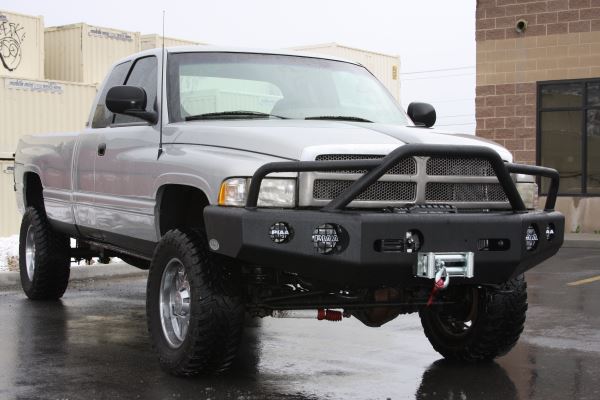 Absorbing
Absorbing
Leaf spring suspension was always accompanied by a shock absorber. The main purpose of the leaf spring is to also absorb road conditions and cushion the ride of the vehicle when on rough terrain. The main purpose of the shock absorber is to dampen a sudden impact to the leaf springs or sudden recoil of the springs after hitting a large obstruction or bump in the road. Shock absorbers are designed to help keep the tires of the vehicle from bouncing and keep them in contact with the road as much as possible. Dodge pickups trucks used the leaf spring front suspension up until 1993. Ford used leaf springs on its four-wheel drives until 2004, and Chevy diesel trucks utilized leaf spring suspension until 1987.
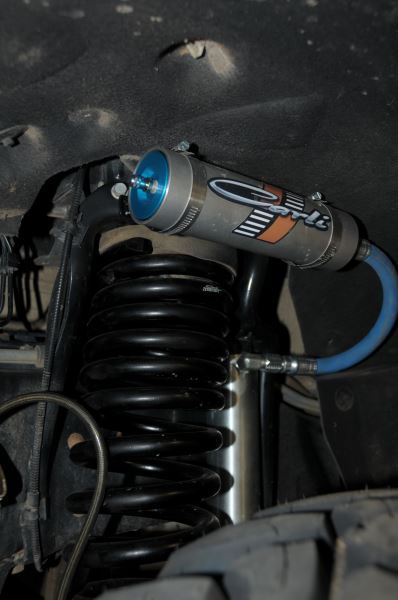 Coil-Over Springs
Coil-Over Springs
The leaf suspension had several desirable features, but also some drawbacks. Leaf springs are usually very strong but because they are not only the suspension but also the alignment for the front axle, they have drawbacks. The use of leaf springs prohibits a tight turning radius of the front tires. The tighter the tires turn the sooner they come in contact with the side of the leaf springs. This is even more exaggerated when wider tires and wheel packages are used. In 1994 Dodge pickup trucks in half-, three-quarter and one-ton categories all utilized coil-over springs, trailing arms and shock absorbers. This utilization of coil over springs on four-wheel drive pickup trucks had several key benefits above and beyond its predecessor the leaf spring. Coil-over suspension offers a smoother ride and tighter turning radius as opposed to leaf springs. This coil-over suspension has withstood the test of time and is being utilized on Dodge pickups with a diesel power plant from 1994 to 2015, both on the two- and four-wheel drive pickup trucks. Ford was a little late to make the transition from leaf spring front suspension to coil-over, but they have also used this type of front suspension on their four-wheel drives from 2004 to 2015. Since the very beginning, diesel-powered two-wheel drive pickup trucks have utilized coil-over suspension. Chevy made the change in 1988 from leaf springs to a different type of front suspension—the torsion bar suspension.
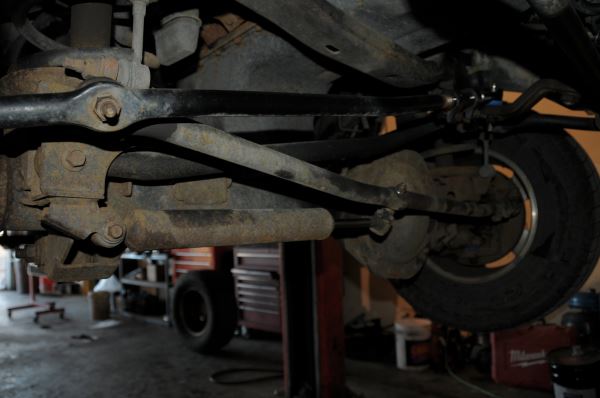 Torsion Bar Suspension
Torsion Bar Suspension
When Chevy pickup trucks made the change from the old box style square body to the newer style of body in 1989, they decided to design a different type of four-wheel drive suspension for their light- and heavy-duty pickup trucks. Chevy decided to utilize torsion bar front suspension in 1989 and are continuing to utilize it up to the current 2015 models. The torsion bar suspension utilizes upper and lower control arms similar to that of a car front suspension and instead of using coil-over springs or struts for soaking up road conditions, they used a torsion bar. The torsion bar has one end fixed stationary to a cross member by means of an adjustable torsion bar key. The other end of the torsion bar is fixed to the lower control arm. As the vehicle goes over bumps the lower and upper control arms move up and down, because the torsion bar is keyed into the lower control arm. Then, as the lower control arms moves up and down, it twists the torsion bar. The bar is designed to be able to twist and provide spring for the vehicle to soak up varying road conditions.
One might ask what the benefits to this type of suspension might be. They are many. The ride of a torsion bar suspension when set up properly is next to a luxury car. The spring stiffness is adjustable due to the adjustability of the torsion key. Torsion bars are very tough and rarely fail, as well as many other pros to this type of setup. The cons to this type of suspension are more moving parts to fail or wear out prematurely, the overall toughness of this type of suspension was not in comparison to the old tried and true leaf spring, and aftermarket lift kits were very expensive.
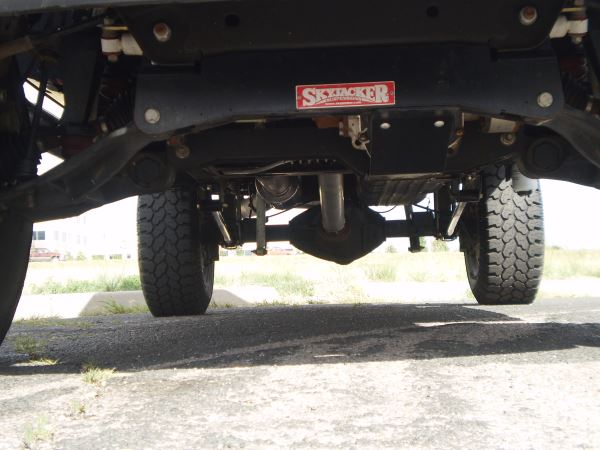
Rear Suspension
Now that the front suspension has been reviewed on diesel pickups from past to present, let’s discuss the rear axle suspension options over the years. Gasoline- and diesel-powered pickup trucks over the years have always utilized leaf spring and shock absorber rear suspensions. There have been several variations of the leaf spring pack but it has always been leaf springs with as few exceptions of Chevy utilizing coil-over spring suspension in their late 60s to early 70s pickup trucks. For the last 30 years Chevy, Ford and Dodge have used progressive spring packs which used a regular spring pack and overload springs bolted to them. This type of spring pack was able to handle heavy loads without sacrificing ride characteristics. Some diesel pickup truck owners have increased load capacity of their three-quarter-ton and one-ton trucks in several ways.
The first addition is to add helper springs to a spring pack to increase the weight-bearing capacity of the pack. The second is the addition of larger overload springs. This type of spring is not utilized until the truck’s spring pack is compressed down to a certain point and the overload springs then begin to push against their stops. The third (and probably most effective) addition to a spring pack to increase payload capacity is that of air bags. Usually air bags are mounted over the center of the leaf spring pack and utilize Pascal’s law of hydraulics and pneumatics. The law states that pressure multiplied by area equals force. For example, a 3-inch diameter air bag mounted over the top of the leaf springs has an effective area of roughly 9 square inches. If we fill the bag with 100 psi of air then we have 900 pounds of force that the air bag can exert to help the springs stay up and not sag. Now take that times two (one for each side of the axle) and we have effectively raised our payload capacity by 1800 pounds! Well, needless to say, the manufacturers have caught on and Chrysler is now offering a true air ride suspension similar to that of heavy-duty over -the-road semi- trucks rear suspension.
The various front and rear suspension designs have been reviewed over the years. It is apparent that leaf springs have had remarkable staying power with the popular brands of diesel-powered pickups. It can also be said that other suspension types have been utilized and have prevailed as well. The respected Winston Churchill once said, “To improve is to change; to be perfect is to change often.”
The idea that suspension setups are at their climax is ridiculous, we have only began to touch the surface of the possibilities in ride control. One thing is for certain though, on a recent test drive in a 2014 Dodge Ram diesel, the ride quality is a night and day difference to the 1989 Dodge I bucked around in years ago. I am certain the same can be said for not just Dodge, but for Ford and Chevy diesel pickups today as well.
About The Author
Levi Perkins is the head instructor for the diesel program at the College of Southern Idaho located in Twin Falls, Idaho. The diesel program has had 100 percent placement in the last three years and provides future diesel mechanics and engineers a bright future in the diesel industry. For more information visit www.csi.edu or call 208-733-9554.